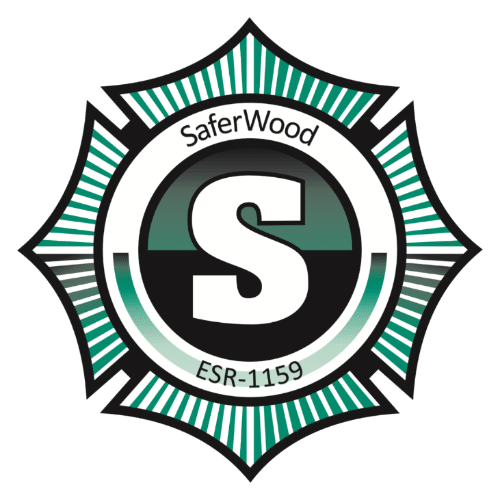Code Compliance and Specifications
InDEPENDENT THIRD-party evaluation reports
- QAI Code Evaluation Report CERus-1031 (USA)
- QAI Code Evaluation Report CERus-1042 (USA)
- ICC-ES Certified ESR-1159 (USA)
- ICC-ES Certified ESL-1021 (Canada)
- ICC-ES Certified ESR-1410 Fire Retardant Wood Roofing
- CAL-FIRE #2520-1450:0502 Fire Retardant Treated Redwood & Western Red Cedar; pressure impregnated.
STAINS AND COATINGS
LIMITED LIFETIME WARRANTY
CODE COMPLIANCE STATEMENTS
MILITARY APPROVAL
-
U.S. Navy QPL under performance specification MIL-L-19140E Lumber & Plywood, Fire Retardant Treated.
NATIONAL BUILDING CODE OF CANADA
-
CAN/ULC S102: Standard Method of Test for Surface Burning Characteristics of Building Materials and Assemblies
TESTING CREDENTIALS
Ignition Resisant (IR) per IWUIC Section 503.2, Item 3, FRTW
Fire Retardant (FR) pressure treatment per IBC 2303.2.1
Class A Fire-Test Response per ASTM E84/UL 723 (ASTM E2768) Extended 30 Minutes
ASTM D2898 Accelerated Weathering “800 inch rain test” Method A before ASTM E2768
Downloads
- Chemco A&E Technical and Design Guide
- Chemco CSI 06 05 73.13
- Common Questions
- How To Read an ICC Report
- Why Code Officials Accept ICC ESR Reports
- Code Adoption Maps
- SaferWood Code Compliance
- FRTW vs. Coating
- Which Areas are most at risk of wildfires?
- What is WUI?
- Wild Fire Statistics
- Guidance for Properly Specifying and Using Fire Retardant Wood Products
FAQ
International Building Code, Section 2303.2, defines fire-retardant-treated wood (FRTW) as: “Wood products impregnated with chemicals by a pressure process.”
IBC § 2303.2.1 defines pressure process as: “For wood products impregnated with chemicals by a pressure process, the process shall be performed in closed vessels under pressures not less than 50 pounds per square inch gauge (psig) (345 kPa).”
It depends. In a designated WUI (Wildland Urban Interface) zone where the IWUIC (International Wildland Urban Interface Code) has been adopted, along with the 2018 IBC, if using wood building products, then an ignition resistant FRTW is required by code. If you are building in a non-WUI zone, or where the IWUIC has not been adopted then it is not required but may be selected by other codes, design considerations, or the client.
It depends. Is it an exterior application? Most fire retardant coatings are “interior use” only. In a designated WUI zone where the IWUIC has been adopted, the answer is no. The 2018 edition of the IBC clarifies what is allowed in Section 2303.2.2: “The use of paints, coating, stains or other surface treatments is not an approved method of protection as required in this section.”
Yes. However, please consult SaferWood-Chemco for recommendations. Our proprietary fire retardant, Thermex-FR, is formulated to be ignition-resistant and is the only pressure impregnated fire-retardant to successfully pass a 10-year outdoor weathering test. The very nature of our ability to prevent the spread of flame and smoke, and extend weathering, also means choosing the correct stain, paint, or coating for proper compatibility.
Unless the local AHJ (Authority Having Jurisdiction) has prohibited its use the answer is, yes. SaferWood treated wood building products are ignition resistant and comply with IWUIC.
Per the International Wildland Urban Interface (WUI) Code Section 504.3 Protection of Eaves: Eaves and soffits shall be protected on the exposed underside by ignition-resistant materials or by material approved for not less than 1-hour fire-resistance-rated construction, 2-inch (51 mm) nominal dimension lumber, or 1-inch (25 mm) nominal fire-retardant-treated lumber or 3/4-inch (19.1 mm) nominal fire-retardant-treated plywood, identified for exterior use and meeting the requirements of Section 2303.2 of the International Building Code. Fascias are required and shall be protected on the backside by ignition-resistant materials or by materials approved for not less than 1-hour fire-resistance-rated construction or 2-inch (51 mm) nominal dimension lumber.
In most cases, no. To be fully compliant with IBC and IWUIC, an ignition-resistant wood building material must pass an extended fire-test for a total duration of 30 minutes. Outside a WUI zone or where the IWUIC has not been adopted a thermally modified wood product that has passed a 10-minute fire-test is acceptable for use. It is important to confirm two things: 1) most recent code adopted, and 2) WUI designation.
Yes. If it can fit in our tube, then we can treat it. Max size of material: 4 ft wide x 50 ft long.
Yes and no. ASTM E84/UL 723 is a Class A rating but to achieve this a wood building product must only pass a 10-minute fire-test. IBC and IWUIC ignition-resistant FRTW must pass an extended 20-minute fire-test for a total duration of 30-minutes. Essentially, achieving better than Class A. It is critical to understand this distinction and verify any product claiming to be WUI compliant and Class A has passed the extended 30-minute fire-test for flame spread and smoke development, and this is only performed after ASTM D2898 Accelerated Weathering.
Fire-retardant-treated products for exterior applications must be subjected to actual or accelerated weathering prior to fire testing. Sometimes referred to as the “800-inch rain test,” the ASTM D2898 test has two methods to simulate weathering. Method A subjects the materials to 12 one-week condition cycles of 96 hours of water exposure and 72 hours of drying at 140 degrees F, the equivalent of 800 inches of rainfall over 12 weeks. Method B subjects materials to 1,000 hours of 24-hour exposures featuring four hours of wetting, four hours of drying and eight hours of resting, with drying time at 150 degrees F with continuous UV exposure.
- Ignition resistant per IWUIC Section 503.2, Item 3, FRTW
- Fire retardant pressure treatment per IBC 2303.2.1
- ASTM E2768-11 Fire-Test-Response Extended 30 Minutes per ASTM E84/UL 723
- ASTM D2898-10 Accelerated Weathering per ASTM E84/UL 723
- Kiln-dried after treatment (KDAT) per IBC 2303.2.8 for moisture content
- Certification by an independent third-party quality control agency with IAS accreditation, i.e., ICC, ICC-ES, UL.

